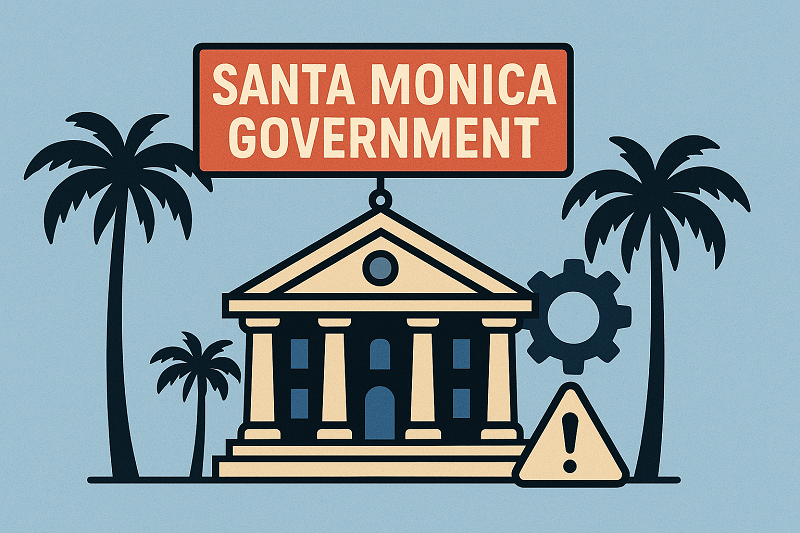
Residents of Santa Monica rarely question how their local government works. Debate usually focuses on housing, homelessness, or budgets—not on the machinery producing those outcomes. But the City Council–City Manager system creates a power imbalance: part-time, often inexperienced council members struggle to set priorities, while unelected staff make the real decisions. The result can be inefficiency and policies misaligned with community needs.
The Illusion of Oversight
The seven elected council members, many without backgrounds in management, finance, or planning, are expected to represent neighborhood and residents’ concerns, rather than outside interests that may have conflicting agendas. Their formal role is to direct the city manager, who runs daily operations. In practice, professional staff, planners, administrators, and finance officers dominate. They outlast council terms and shape projects before elected officials even see them.
During the homelessness crisis, for instance, the council often approved staff-recommended service contracts without independent audits or clear performance measures. Similarly, planning and zoning changes, like state-mandated housing increases, are mainly negotiated by staff with developers, leaving council members to potentially review and approve projects that have already been outlined without prior input.
Budgeting Without Accountability
Santa Monica’s $700-million budget would challenge even veteran administrators. Council members, lacking technical expertise, depend on staff presentations. During COVID-19 budget cuts, staff rapidly eliminated positions like police officers and library employees but preserved high executive salaries. Council lacked the tools to contest these choices, giving the impression that staff protected themselves over the public interest.
Staff as De Facto Directors
Because they control information and timelines, staff effectively direct city policy. Council members, buried under dense reports and short deadlines, cannot comprehensively analyze or strategize. This weakens democratic oversight and leaves voters with representatives who struggle to shape policy meaningfully.
The Structural Question
The council–manager model was created a century ago to professionalize administration and prevent corruption. Today, it can create a democratic deficit: voters elect representatives with limited control, while unaccountable staff steer the city.
A strong mayor system could change this. A directly elected, well-compensated mayor could attract candidates with proven expertise in urban management, finance, or law. A mayor would set priorities, defend them publicly, and take responsibility—qualities missing in today’s diffusion of responsibility.
Alternatively, a hybrid model that blends a strong mayor with an empowered council could preserve checks and balances while enhancing accountability and expertise.
How a Hybrid Could Work
Define Clear Separation of Powers
- The mayor as Chief Executive: Controls hiring and firing of department heads, budget preparation, and policy execution.
- Council as Legislature: Approve ordinances, land-use changes, budgets, and major service restructuring (e.g., outsourcing trash collection).
Independent Support for Council Members
- Legislative Assistants: Each council member should have an independent aide or policy analyst to research issues, draft proposals, and vet staff recommendations.
- Separate Offices and Budget: Provide a modest council budget for constituent services and policy development, reducing dependence on executive-filtered information.
Collaborative Decision-Making
- Executive-Legislative Briefings: Hold biweekly meetings between the mayor and a council leadership committee to align priorities.
- Joint Strategic Planning: Require an annual retreat for the mayor, council, and department heads to set goals and metrics.
- Veto and Override: Allow the mayor veto power, but let council override by supermajority, forcing negotiation.
Independent Oversight and Public Accountability
- Strengthened Auditor: An independent auditor reporting to council could evaluate program performance and finances.
- Sunshine Rules: Mandate public disclosure of mayoral directives, budget changes, and vendor negotiations, with independent council review.
Examples of Hybrid Approaches
San Diego, CA: Transitioned to a strong mayor but retained a robust council with veto-override power.
Denver, CO: Uses a strong mayor with council aides and resources to balance power.
New York City: The mayor wields executive authority, but the council negotiates budgets and passes laws with independent staff support.
TO BE CONTINUED IN PART 2 NEXT WEEK
Michael Jolly for SMa.r.t.
Santa Monica Architects for a Responsible Tomorrow
Mario Fonda-Bonardi, AIA, former Planning Commissioner, Robert H. Taylor, AIA, Architect, Dan Jansenson, former Building and Life Safety Commissioner, Samuel Tolkin, Architect, former Planning Commissioner, Michael Jolly, AIR-CRE, Jack Hillbrand, AIA, Landmarks Commission Architect













